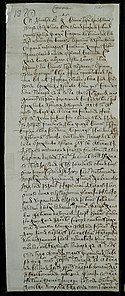Russian cursive
This article may be confusing or unclear to readers. (November 2018) |
Russian cursive is a printed variant of the Russian alphabet, typically referred to as (ру́сский) рукопи́сный шрифт (rússky) rukopísny shrift, "(Russian) handwritten font". It is the handwritten form of the modern Russian Cyrillic script, used instead of the block letters seen in printed material. In addition, Russian italics for lowercase letters are often based on Russian cursive (such as lowercase т, which resembles Latin m). Most handwritten Russian, especially in personal letters and schoolwork, uses the cursive alphabet. In Russian schools most children are taught from first grade how to write with this script.
History[]

The Russian (and Cyrillic in general) cursive was developed during the 18th century on the base of the earlier Cyrillic tachygraphic writing (ско́ропись, "rapid or running script", which in turn was the 14th–17th chancery hand of the earlier Cyrillic bookhand scripts (called ustav and poluustav). It became the handwritten counterpart of so-called "civil" (or Petrine) printed script of books. In order, modern Cyrillic italic typefaces are based (in their lowercase part) mostly on the cursive shape of the letters.

The resulting cursive bears many similarities with the Latin cursive.[1] For example, the modern Russian cursive letters "АВДЕИКМНОРСУХ авдезиопрстухч" may coincide with Latin cursive "ABDEUKMHOPCYX abgezuonpcmyxr" (